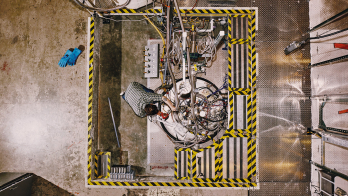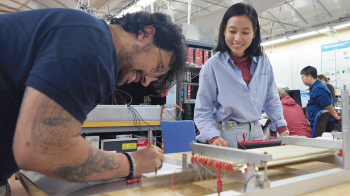Progress in detector technology is alive and well.

Image credit: Nanni Darbo.
The last week of May saw a gathering of 390 physicists from 27 countries and four continents on the island of Elba. The 13th edition of the Pisa Meeting on Advanced Detectors for Frontier Physics took place in the secluded Biodola area. The conference, which takes place every three years, is based on a consolidated format, aiming at an interdisciplinary exchange of ideas: all sessions are plenary, with a round table on a topic of interest (CERN Courier July/August 2006 p31). The programme for this year was built on a record number of contributions (more than 400), out of which 327 were selected for either oral (66) or poster presentations. Eight industries were present throughout the meeting, with stands to display their products and to discuss ongoing and future R&D projects.
The opening session saw an introductory talk by Toni Pich of Valencia that described the situation in frontier physics today. The discovery of a particle associated with the Brout–Englert–Higgs mechanism has opened a whole new field of investigation to explore, in addition to the “known unknowns”. Among these, revealing the nature of dark matter and of neutrino masses is the main priority. In the following talk, CERN’s Michelangelo Mangano discussed the search for supersymmetry, as well as different possibilities for signals of new physics that will be explored with high priority from the start of Run 2 at the LHC.

Image credit: Nanni Darbo.
A key event was the round table organized on the second day of the meeting, with 13 people representing nine laboratories (CERN, the Institute of High Energy Physics (IHEP) in Beijing, Fermilab, PSI, TRIUMF, the European Spallation Source, KEK and the Japan Proton Accelerator Research Complex) and four funding agencies (the US Department of Energy, the Institut national de physique nucléaire et de physique des particules (IN2P3), the Istituto Nazionale di Fisica Nucleare (INFN) and the UK’s Science and Technology Facilities Council). The topic for discussion was “Synergies and complementarity among laboratories”, in view of the challenges of the coming decades and of the growing role of CERN as the place where the energy frontier will be explored. The presentation about the future of high-energy physics in China by Gang Chen of IHEP was particularly enlightening, giving a perspective and an impressive plan spanning the middle of this century. Representatives of the funding agencies discussed the nearer future, where – besides the High Luminosity LHC project – a strong neutrino programme is foreseen. The lively exchange among the scientists at the table and participants on the floor left everyone with a vivid perception that what Sergio Bertolucci, CERN’s director for research and computing, defined as “co-opetition” among different institutions in high-energy physics, must move forward and become part of the texture of daily work. Several participants stressed that although CERN is central, regional laboratories have an important role because they relate directly to the host nations. Demonstrating the societal impact of research in high-energy physics to politicians and to the public at large is a key point in obtaining support for the whole field.
Each Pisa meeting has a number of standard sessions on gas and solid-state detectors, particle and photon identification, calorimetry and advanced electronics, astroparticle physics, and the application of high-energy-physics techniques in other fields. The presentations, both oral and with posters, demonstrated that significant improvements in existing detectors and current techniques are still possible. The topics presented covered dedicated R&D as well as novel ideas, some developed in a beneficial crossover with other areas, ranging from material science to nanotechnology and chemistry. In a dedicated session, speakers from the LHC experiments noted that the detectors are now performing well and are ready to help harvest the physics at 13 TeV that will come from the LHC’s Run 2.

Image credit: Nanni Darbo.
As the field keeps changing, so does the conference. This year, a new session was introduced to offer adequate space to applied superconductivity. The technique is now fundamental, not just to provide stronger magnetic fields for accelerators and spectrometers, but also in specialized detectors. The review talk by Akira Yamamoto of KEK and CERN outlined the new frontier of superconducting magnets, both in terms of achievable field and of stored energy/mass ratio. Emanuela Barzi and Alexander Zoblin presented the R&D programme for high-field superconducting magnets at Fermilab. The laboratory that pioneered the use of superconducting magnets in accelerators now aims to be able to build magnets suitable for the Future Circular Collider design study (CERN Courier April 2014 p16). The use of superconducting materials to detect photons was discussed in two talks, by Martino Calvo of CNRS Grenoble and Roberto Leoni of IFN-CNR, Rome. The use of cryogenic detectors – bolometers, kinetic-inductance detectors, transition-edge sensors, to name but a few – was discussed by Flavio Gatti of INFN Genova, in a review of the large number of posters on the subject presented at the conference.
The meeting saw the awarding of the first Aldo Menzione Prize. Among his many activities, Aldo was one of the founders of the Pisa meeting and recipient of the W K H Panokfsky Prize in 2009. He passed away in December 2012 (CERN Courier April 2013 p37), and to honour his memory, the Frontier Detectors for Frontier Physics (FDFP) association that organizes the conference series, established an award to be assigned at each meeting to “a distinguished scientist who has contributed to the development of detector techniques”. The recipients of the prize on this first occasion were David Nygren, now of the University of Texas at Arlington, for the invention of the time-projection chamber, and Fabio Sauli, now of the TERA Foundation, for the invention of the gas electron-multiplier, or GEM. The prizes were presented by Donata Foà, Aldo’s widow, and Angelo Scribano, the president of the FDFP.

Image credit: Nanni Darbo.
At the end of the conference dinner, several awards were also assigned by an international jury. Elsevier established two Elsevier Young Scientist Awards to honour the late Glenn Knoll, who was an editor of Nuclear Instruments and Methods (NIM). These were presented by Fabio Sauli, on behalf of NIM, to Filippo Resnati of CERN and Joana Wirth of the Technische Universität München, respectively, for his talk on the “Charge transfer properties through graphene for applications in gaseous detectors”, and for her poster on “CERBEROS: a tracking system for secondary pion beams at the HADES spectrometer”. Three FDFP awards to “talented young scientists active in the development of detection techniques and contributing, by talk or poster, to the scientific programme” were conferred by Angelo Scribano to Lars Graber of the University of Göttingen for his talk on “A 3D diamond detector for particle tracking”, Roberto Acciarri of Fermilab for a poster on “Experimental study of breakdown electric fields in liquid argon” and Raffaella Donghia of INFN-LNF for her poster on “Time performances and irradiation tests of CsI crystals read-out by MPPC”.
Concluding the conference, the chair, Marco Grassi of INFN-Pisa, provided a few statistics. He remarked that 36% of the participants were below 35 years old and nearly all of them – 96% – contributed to the conference programme with oral presentations or posters. This demonstrates that the field of detector development is attractive and has a strong basis on which it can grow, as long as, at a national level, institutes can continue to recruit these young scientists. This, as Catherine Clerc from IN2P3 reminded everybody during the round table, is the most pressing challenge in many European countries.
• For further information, visit the conference website https://agenda.infn.it/conferenceDisplay.py?confId=8397, where all of the presentations (oral and posters) are available.







